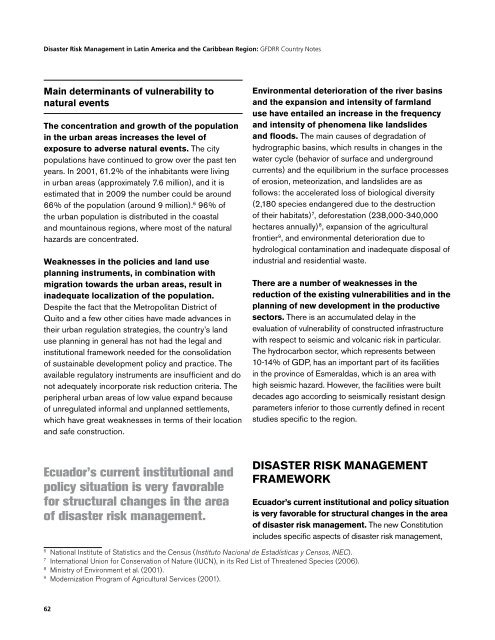Ecuador - GFDRR
Ecuador - GFDRR
Ecuador - GFDRR
You also want an ePaper? Increase the reach of your titles
YUMPU automatically turns print PDFs into web optimized ePapers that Google loves.
Disaster Risk Management in Latin America and the Caribbean Region: <strong>GFDRR</strong> Country Notes<br />
Main determinants of vulnerability to<br />
natural events<br />
The concentration and growth of the population<br />
in the urban areas increases the level of<br />
exposure to adverse natural events. The city<br />
populations have continued to grow over the past ten<br />
years. In 2001, 61.2% of the inhabitants were living<br />
in urban areas (approximately 7.6 million), and it is<br />
estimated that in 2009 the number could be around<br />
66% of the population (around 9 million). 6 96% of<br />
the urban population is distributed in the coastal<br />
and mountainous regions, where most of the natural<br />
hazards are concentrated.<br />
Weaknesses in the policies and land use<br />
planning instruments, in combination with<br />
migration towards the urban areas, result in<br />
inadequate localization of the population.<br />
Despite the fact that the Metropolitan District of<br />
Quito and a few other cities have made advances in<br />
their urban regulation strategies, the country’s land<br />
use planning in general has not had the legal and<br />
institutional framework needed for the consolidation<br />
of sustainable development policy and practice. The<br />
available regulatory instruments are insufficient and do<br />
not adequately incorporate risk reduction criteria. The<br />
peripheral urban areas of low value expand because<br />
of unregulated informal and unplanned settlements,<br />
which have great weaknesses in terms of their location<br />
and safe construction.<br />
Environmental deterioration of the river basins<br />
and the expansion and intensity of farmland<br />
use have entailed an increase in the frequency<br />
and intensity of phenomena like landslides<br />
and floods. The main causes of degradation of<br />
hydrographic basins, which results in changes in the<br />
water cycle (behavior of surface and underground<br />
currents) and the equilibrium in the surface processes<br />
of erosion, meteorization, and landslides are as<br />
follows: the accelerated loss of biological diversity<br />
(2,180 species endangered due to the destruction<br />
of their habitats) 7 , deforestation (238,000-340,000<br />
hectares annually) 8 , expansion of the agricultural<br />
frontier 9 , and environmental deterioration due to<br />
hydrological contamination and inadequate disposal of<br />
industrial and residential waste.<br />
There are a number of weaknesses in the<br />
reduction of the existing vulnerabilities and in the<br />
planning of new development in the productive<br />
sectors. There is an accumulated delay in the<br />
evaluation of vulnerability of constructed infrastructure<br />
with respect to seismic and volcanic risk in particular.<br />
The hydrocarbon sector, which represents between<br />
10-14% of GDP, has an important part of its facilities<br />
in the province of Esmeraldas, which is an area with<br />
high seismic hazard. However, the facilities were built<br />
decades ago according to seismically resistant design<br />
parameters inferior to those currently defined in recent<br />
studies specific to the region.<br />
<strong>Ecuador</strong>’s current institutional and<br />
policy situation is very favorable<br />
for structural changes in the area<br />
of disaster risk management.<br />
disaster risk management<br />
framework<br />
<strong>Ecuador</strong>’s current institutional and policy situation<br />
is very favorable for structural changes in the area<br />
of disaster risk management. The new Constitution<br />
includes specific aspects of disaster risk management,<br />
6<br />
National Institute of Statistics and the Census (Instituto Nacional de Estadísticas y Censos, INEC).<br />
7<br />
International Union for Conservation of Nature (IUCN), in its Red List of Threatened Species (2006).<br />
8<br />
Ministry of Environment et al. (2001).<br />
9<br />
Modernization Program of Agricultural Services (2001).<br />
62

















